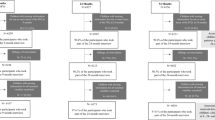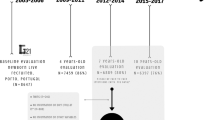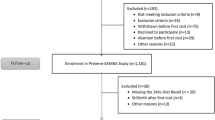Abstract
BACKGROUND/OBJECTIVES:
Data from the Avon Longitudinal Study of Parents and Children (ALSPAC) have previously shown that dietary patterns are observable by 3 years. However, it is not clear when dietary patterns emerge. We aimed to describe dietary patterns in early life and their associations with maternal and infant sociodemographic characteristics.
SUBJECTS/METHODS:
Principal component analysis was applied to diet questionnaires of ALSPAC participants at 6 months (n=7052) and 15 months (n=5610) to extract dietary patterns. The sociodemographic factors associated with dietary patterns were investigated using regression analyses.
RESULTS:
Four dietary patterns were extracted at both 6 and 15 months. A traditional-style pattern characterized by home-prepared meats, vegetables and desserts, a second pattern characterized by ready-prepared baby foods and a third pattern characterized by discretionary foods such as biscuits, sweets and crisps were identified at both ages. At 6 months, the fourth pattern was characterized predominantly by breastfeeding and at 15 months, by contemporary-style foods including herbs, legumes, nuts, raw fruit and vegetables. Higher maternal age and education, number of siblings and lower body mass index (BMI) was associated with higher scores on the breastfeeding or meat, vegetables and desserts patterns, whereas higher discretionary food pattern scores were associated with younger maternal age, lower education, higher BMI and more siblings. Associations between sociodemographic factors and the ready-prepared baby food pattern scores were inconsistent across ages.
CONCLUSIONS:
Dietary patterns emerge from infancy and are associated with sociodemographic characteristics.
This is a preview of subscription content, access via your institution
Access options
Subscribe to this journal
Receive 12 print issues and online access
$259.00 per year
only $21.58 per issue
Buy this article
- Purchase on Springer Link
- Instant access to full article PDF
Prices may be subject to local taxes which are calculated during checkout

Similar content being viewed by others
References
Northstone K, Emmett PM . Are dietary patterns stable throughout early and mid-childhood? A birth cohort study. Br J Nutr 2008; 100, 1069–1076.
Smithers LG, Golley RK, Brazionis L, Lynch JW . Characterizing whole diets of young children from developed countries and the association between diet and health: a systematic review. Nutr Rev 2011; 69, 449–467.
Robinson S, Marriott L, Poole J, Crozier S, Borland S, Lawrence W et al. Dietary patterns in infancy: the importance of maternal and family influences on feeding practice. Br J Nutr 2007; 98, 1029–1037.
Ystrom E, Niegel S, Vollrath ME . The impact of maternal negative affectivity on dietary patterns of 18-month-old children in the Norwegian Mother and Child Cohort Study. Matern Child Nutr 2009; 5, 234–242.
Golding J, the ALSPAC Study Team. Children of the nineties: a resource for assessing the magnitude of long-term effects of prenatal, perinatal and subsequent events. Contemp Rev Obstet Gynaecol 1996; 8, 89–92.
Emmett P . Dietary assessment in the Avon Longitudinal Study of Parents and Children. Eur J Clin Nutr 2009; 63 (Suppl 1), S38–S44.
Noble S, Emmett P . Differences in weaning practice, food and nutrient intake between breast- and formula-fed 4-month-old infants in England. J Hum Nutr Diet 2006; 19, 303–313.
Office of Population Censuses & Surveys. Standard Occupational Classification. Her Majesty's Stationery Office: London, 1991.
Field A . Chapter 17: Exploratory factor analysis. In: Discovering Statistics Using SPSS, 3rd edn. SAGE Publications Ltd: London, 2006, pp 627–685.
Costello AB, Osborne JW . Best practices in exploratory factor analysis: four recommendations for getting the most from your analysis. Practical Assess Res Eval 2005; 10. Available online at: http://pareonline.net/getvn.asp?v=10&n=7.
Gorusch RL . Factor Analysis. Lawrence Erlbaum: Hillsdale, NJ, 1983, pp 142–174.
McCann SE, Marshall JR, Brasure JR, Graham S, Freudenheim JL . Analysis of patterns of food intake in nutritional epidemiology: food classification and in principal components analysis and the subsequent impact on estimates for endometrial cancer. Public Health Nutr 2001; 4, 989–997.
DiStefano C, Zhu M, Mindrila D . Understanding and using factor scores: considerations for the applied researcher. Practical Assess Res Eval 2009; 14. Available online at: http://pareonline.net/getvn.asp?v=14&n=20.
Tabachnick BG, Fidell LS . Principal components and factor analysis. In: Hartman S (ed) Using Multivariate Statistics, 5th edn. Pearson Education Inc.: Boston, MA, 2007, pp 607–675.
Northstone K, Emmett P, ALSPAC Study Team. Multivariate analysis of diet in children at four and seven years of age and associations with socio-demographic characteristics. Eur J Clin Nutr 2005; 59, 751–760.
Briefel RR, Reidy K, Karwe V, Jankowski L, Hendricks K . Toddlers’ transition to table foods: impact on nutrient intakes and food patterns. J Am Diet Assoc 2004; 104 (1 Suppl 1), s38–s44.
Hu FB, Rimm E, Smith-Warner SA, Feskanich D, Stampfer MJ, Ascherio A et al. Reproducibility and validity of dietary patterns assessed with a food-frequency questionnaire. Am J Clin Nutr 1999; 69, 243–249.
North K, Emmet P, Avon Longitudinal Study of Pregnancy and Childhood (ALSPAC) Study Team. Multivariate analysis of diet among three-year-old children and associations with socio-demographic characteristics. Eur J Clin Nutr 2000; 54, 73–80.
Kramer MS, Fombonne E, Igumnov S, Vanilovich I, Matush L, Mironova E et al. Effects of prolonged and exclusive breastfeeding on child behavior and maternal adjustment: evidence from a large, randomized trial. Pediatrics 2008; 121, e435–e440.
Golley RK, Hendrie GA, McNaughton SA . Scores on the Dietary Guideline Index for children and adolescents are associated with nutrient intake and socio-economic position but not adiposity. J Nutr 2011; 141, 1340–1347.
Acknowledgements
We are extremely grateful to all the families who took part in this study, the midwives for their help in recruiting them, and the whole ALSPAC team, which includes interviewers, computer and laboratory technicians, clerical workers, research scientists, volunteers, managers, receptionists and nurses. The UK Medical Research Council, the Wellcome Trust and the University of Bristol provide funding for the ALSPAC study. JWL is supported by an Australia Fellowship and RKG with a Postdoctoral Training Fellowship from the National Health and Medical Research Council of Australia. LGS, LB and MNM are supported by funds from the Australia Fellowship awarded to JWL. KN and PE are partly supported by the UK Arthritic Association and partly by funding from the European Community's Seventh Framework Programme (FP7/2007-2013 Grant number 245012).
Author information
Authors and Affiliations
Corresponding author
Ethics declarations
Competing interests
Both PE and KN have received support from commercial infant food manufacturers and have undertaken invited lectures. The other authors declare no conflict of interest.
Additional information
Contributors: LGS, RKG and JWL conceived the project, developed the research plan and oversaw the conduct of the project; PE collected and KN prepared data; LGS and LB analysed the data; the PCA protocol and face validity were developed by LB; all authors assisted with interpretation of the analysis; LGS prepared the first draft of the paper, all authors contributed to further drafts of the manuscript, and all have read and approved the final version; LGS, LB, RKG, MNM and JWL have primary responsibility for the final content.
Supplementary Information accompanies the paper on European Journal of Clinical Nutrition website
Supplementary information
Rights and permissions
About this article
Cite this article
Smithers, L., Brazionis, L., Golley, R. et al. Associations between dietary patterns at 6 and 15 months of age and sociodemographic factors. Eur J Clin Nutr 66, 658–666 (2012). https://doi.org/10.1038/ejcn.2011.219
Received:
Revised:
Accepted:
Published:
Issue Date:
DOI: https://doi.org/10.1038/ejcn.2011.219
Keywords
This article is cited by
-
Maternal determinants of dietary patterns in infancy and early childhood in the Growing up in New Zealand cohort
Scientific Reports (2023)
-
Associations between dietary patterns and anaemia in 6- to 23-month-old infants in central South China
BMC Public Health (2021)
-
Commercial complementary food use amongst European infants and children: results from the EU Childhood Obesity Project
European Journal of Nutrition (2020)
-
Infant dietary patterns and early childhood caries in a multi-ethnic Asian cohort
Scientific Reports (2019)
-
Early factors related to carbohydrate and fat intake at 8 and 12 months: results from the EDEN mother–child cohort
European Journal of Clinical Nutrition (2017)



